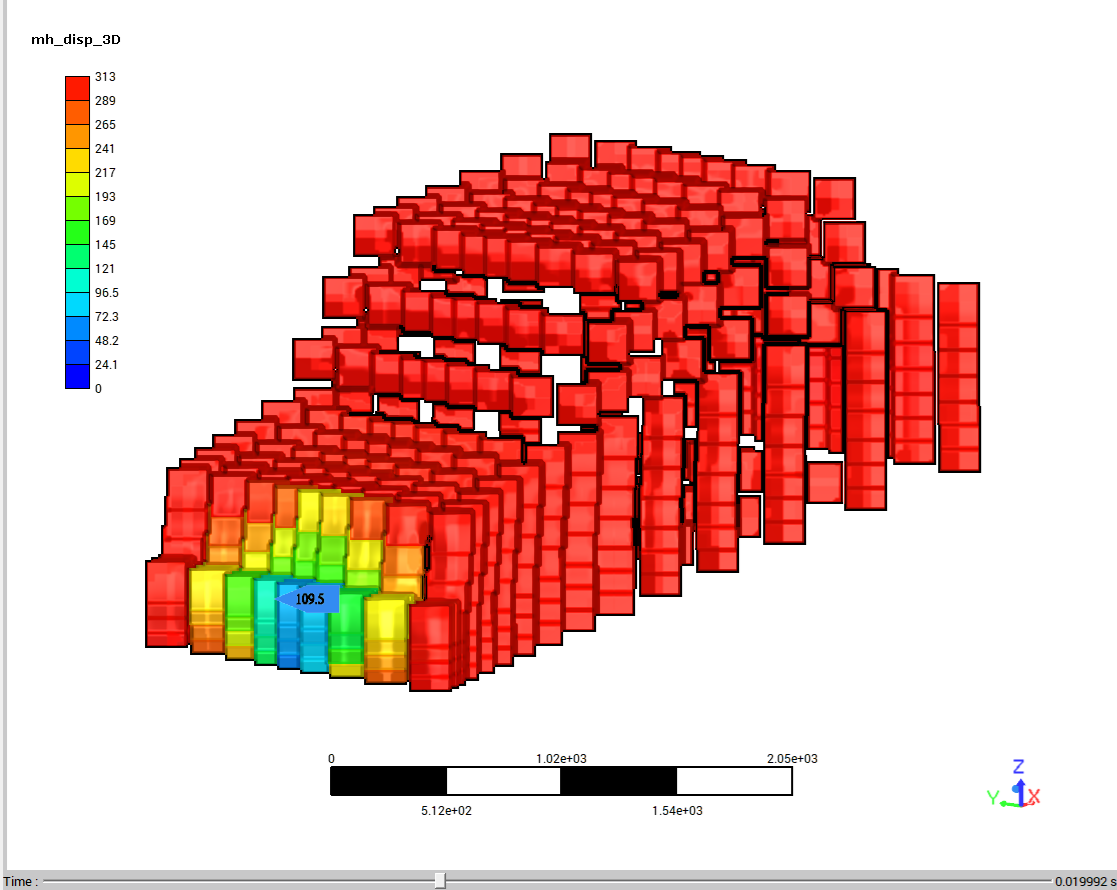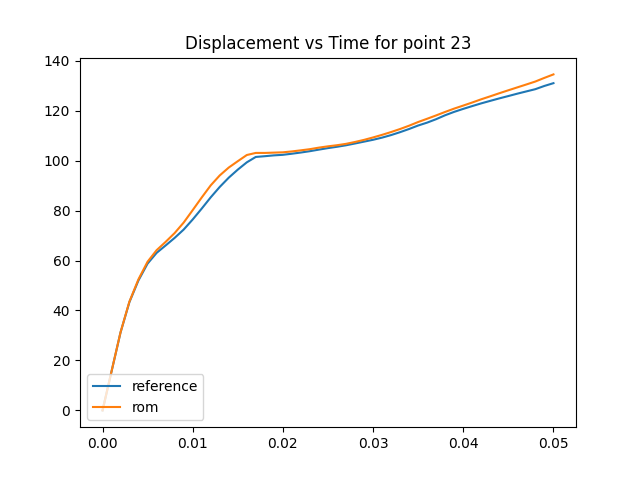Note
Go to the end to download the full example code.
Static ROM creation, Twin generation and evaluation#
This example shows how you can use PyAEDT and PyTwin together. PyAEDT is used on one side to generate a static ROM based on training data, and then create and export a twin model. PyTwin is used on the other side to load and evaluate the generated twin model. Parametric field history results (i.e. transient results collected on a fixed time interval for different parameters values) have been generated out of LS-DYNA simulations. Once the twin is generated, it can be evaluated to make predictions of time series (e.g. transient displacement at a given probe location)
Note
This example requires an installation of Ansys Twin Builder 2025R1 or above.

# sphinx_gallery_thumbnail_path = '_static/TBROM_parametric_field_history.png'
Perform required imports#
Perform required imports, which include downloading and importing the input files.
import csv
import json
import os
import shutil
import zipfile
from ansys.aedt.core import TwinBuilder, generate_unique_project_name
import matplotlib.pyplot as plt
import numpy as np
import pandas as pd
from pytwin import TwinModel, download_file, read_binary
training_data_zip = "training_data.zip"
download_folder = download_file(training_data_zip, "other_files", force_download=True)
training_data_folder = os.path.join(os.path.dirname(download_folder), "training_data")
if os.path.exists(training_data_folder) and os.path.isdir(training_data_folder):
shutil.rmtree(training_data_folder)
# Unzip training data
with zipfile.ZipFile(download_folder) as zf:
zf.extractall(training_data_folder)
C:\Users\ansys\Documents\actions-runner\_work\pytwin\pytwin\.venv\Lib\site-packages\ansys\aedt\core\modeler\schematic.py:40: UserWarning: EMIT API is only available for Python 3.8-3.12.
warnings.warn("EMIT API is only available for Python 3.8-3.12.")
Define auxiliary functions#
Define auxiliary functions for computing # the norm of the output field.
def norm_vector_history(field: np.ndarray, index: int):
"""Compute the norm of a vector field."""
result = []
for i in range(0, field.shape[0]):
vec = field[i, :].reshape((-1, 3))
result.append(np.sqrt((vec * vec).sum(axis=1))[index])
return result
Project settings#
Define Twin Builder project related settings and inputs files. The following code
launches Twin Builder in graphical mode. You can change the Boolean parameter
non_graphical to True to launch Twin Builder in non-graphical mode.
You can also change the Boolean parameter new_thread to False to
launch Twin Builder in an existing AEDT session if one is running.
source_build_conf_file = "SROMbuild.conf"
source_props_conf_file = "SROM_props.conf" # Note : SROM_props.conf may need to be adapted if inputs names change!
desktop_version = "2025.1"
non_graphical = False
new_thread = True
confpath = os.path.join(training_data_folder, source_build_conf_file)
doefile = os.path.join(training_data_folder, "doe.csv")
settingsfile = os.path.join(training_data_folder, "settings.json")
ROM creation#
Create a Twin Builder instance
tb = TwinBuilder(
project=generate_unique_project_name(), version=desktop_version, non_graphical=non_graphical, new_desktop=new_thread
)
# Switch the current desktop configuration and the schematic environment to "Twin Builder" (Static ROM Builder is
# available with Twin Builder).
current_desktop_config = tb.odesktop.GetDesktopConfiguration()
current_schematic_environment = tb.odesktop.GetSchematicEnvironment()
tb.odesktop.SetDesktopConfiguration("Twin Builder")
tb.odesktop.SetSchematicEnvironment(1)
# Get the static ROM builder object
rom_manager = tb.odesign.GetROMManager()
static_rom_builder = rom_manager.GetStaticROMBuilder()
# Build the static ROM with specified configuration file
static_rom_builder.Build(confpath.replace("\\", "/"))
# Test if ROM was created successfully
static_rom_path = os.path.join(training_data_folder, "StaticRom.rom")
if os.path.exists(static_rom_path):
tb.logger.info("Built intermediate rom file successfully at: %s", static_rom_path)
else:
tb.logger.error("Intermediate rom file not found at: %s", static_rom_path)
# Create the ROM component definition in Twin Builder
rom_manager.CreateROMComponent(static_rom_path.replace("\\", "/"), "staticrom")
PyAEDT INFO: Python version 3.13.3 (tags/v3.13.3:6280bb5, Apr 8 2025, 14:47:33) [MSC v.1943 64 bit (AMD64)].
PyAEDT INFO: PyAEDT version 0.21.3.
PyAEDT INFO: Initializing new Desktop session.
PyAEDT INFO: Log on console is enabled.
PyAEDT INFO: Log on file C:\Users\ansys\AppData\Local\Temp\pyaedt_ansys_3667b366-49fa-4e57-ac09-339c58e47e51.log is enabled.
PyAEDT INFO: Log on AEDT is disabled.
PyAEDT INFO: Debug logger is disabled. PyAEDT methods will not be logged.
PyAEDT INFO: Launching PyAEDT with gRPC plugin.
PyAEDT INFO: New AEDT session is starting on gRPC port 63465.
PyAEDT INFO: Electronics Desktop started on gRPC port: 63465 after 12.31926965713501 seconds.
PyAEDT INFO: AEDT installation Path C:\Program Files\AnsysEM\v251\Win64
PyAEDT INFO: Ansoft.ElectronicsDesktop.2025.1 version started with process ID 10328.
PyAEDT INFO: Project Project_PLX has been created.
PyAEDT INFO: No design is present. Inserting a new design.
PyAEDT INFO: Added design 'Twin Builder_25G' of type Twin Builder.
PyAEDT INFO: Aedt Objects correctly read
PyAEDT INFO: Built intermediate rom file successfully at: C:\Users\ansys\AppData\Local\Temp\TwinExamples\other_files\training_data\StaticRom.rom
Twin composition and export#
Define the grid distance for ease in calculations.
G = 0.00254
# Create the Twin Subsheet.
parentDesign = "ParentDesign"
subSheet = "SubSheet"
tb.create_subsheet(subSheet, parentDesign)
idSubSheet = len(tb.odesign.GetSubDesigns())
tb.set_active_design(parentDesign + "::SubSheet" + str(idSubSheet))
# Place the ROM component, parameterize and connect to port interfaces.
rom1 = tb.modeler.schematic.create_component("ROM1", "", "staticrom", [40 * G, 25 * G])
rom1.parameters["field_data_storage_period"] = "0"
rom1.parameters["store_snapshots"] = "1"
tb.modeler.schematic.add_pin_iports("ROM1", rom1.id)
tb.logger.info("Subsheet created, starting Twin compilation")
# twin compilation
twinname = "TwinModel"
tb.odesign.CompileAsTwin(twinname, ["1", "0.001", "1e-4", "1e-12"])
# twin export
twinFile = os.path.join(training_data_folder, twinname + ".twin")
tb.modeler.schematic.o_simmodel_manager.ExportTwinModel(twinname, twinFile, "twin", "other", "1", "1")
tb.logger.info("Twin compiled and exported. Closing Twin Builder.")
# Restore earlier desktop configuration and schematic environment.
tb.odesktop.SetDesktopConfiguration(current_desktop_config)
tb.odesktop.SetSchematicEnvironment(current_schematic_environment)
tb.release_desktop()
PyAEDT INFO: Python version 3.13.3 (tags/v3.13.3:6280bb5, Apr 8 2025, 14:47:33) [MSC v.1943 64 bit (AMD64)].
PyAEDT INFO: PyAEDT version 0.21.3.
PyAEDT INFO: Returning found Desktop session with PID 10328!
PyAEDT INFO: Project Project_PLX set to active.
PyAEDT INFO: Added design 'ParentDesign' of type Twin Builder.
PyAEDT INFO: Aedt Objects correctly read
PyAEDT INFO: Python version 3.13.3 (tags/v3.13.3:6280bb5, Apr 8 2025, 14:47:33) [MSC v.1943 64 bit (AMD64)].
PyAEDT INFO: PyAEDT version 0.21.3.
PyAEDT INFO: Returning found Desktop session with PID 10328!
PyAEDT INFO: Project Project_PLX set to active.
PyAEDT INFO: Active Design set to 1;ParentDesign/2;SubSheet
PyAEDT INFO: Aedt Objects correctly read
PyAEDT INFO: ModelerCircuit class has been initialized! Elapsed time: 0m 0sec
PyAEDT INFO: ModelerTwinBuilder class has been initialized!
PyAEDT INFO: Parsing C:\Users\ansys\AppData\Local\Temp\pyaedt_prj_CNW\Project_PLX.aedt.
PyAEDT INFO: File C:\Users\ansys\AppData\Local\Temp\pyaedt_prj_CNW\Project_PLX.aedt correctly loaded. Elapsed time: 0m 0sec
PyAEDT INFO: aedt file load time 0.02984023094177246
PyAEDT INFO: Subsheet created, starting Twin compilation
PyAEDT INFO: Twin compiled and exported. Closing Twin Builder.
PyAEDT INFO: Desktop has been released and closed.
True
Twin evaluation#
Evaluate the exported Twin with PyTwin and post process the results
# Read column header names
input_header_df = pd.read_csv(doefile, header=None, nrows=1, sep=r";\s+", engine="python", quoting=csv.QUOTE_ALL)
# Read data, clean header names, and assemble final dataframe
inputs_df = pd.read_csv(doefile, header=None, skiprows=1, sep=";")
inputs_header_values = input_header_df.iloc[0][0].split(";")
inputs_df.columns = inputs_header_values
inputs = dict()
data_index = 0
for column in inputs_df.columns[1::]:
inputs[column] = inputs_df[column][data_index]
# Read settings file
with open(settingsfile) as f:
data = json.load(f)
timeGrid = data["timeSeries"]["timeStepsValues"]
romdim = int(data["dimensionality"][0])
# Load and evaluate the Twin
print("Loading model: {}".format(twinFile))
print("Twin inputs evaluated: {}".format(inputs))
twin_model = TwinModel(twinFile)
romname = twin_model.tbrom_names[0]
twin_model.initialize_evaluation(inputs=inputs)
Loading model: C:\Users\ansys\AppData\Local\Temp\TwinExamples\other_files\training_data\TwinModel.twin
Twin inputs evaluated: {'tbumper': np.float64(3.0), 'thood': np.float64(1.0)}
Results post processing#
The time history predictions for a particular probe (point #23) are post processed and compared to reference results.
ref_snapshot = os.path.join(training_data_folder, "snapshots", inputs_df[inputs_df.columns[0]][data_index])
ref_data = read_binary(ref_snapshot).reshape(len(timeGrid), -1)
snapshot = twin_model.get_snapshot_filepath(romname)
snap_data = read_binary(snapshot).reshape(len(timeGrid), -1)
probe_id = 23
plt.plot(timeGrid, norm_vector_history(ref_data, probe_id), label="reference")
plt.plot(timeGrid, norm_vector_history(snap_data, probe_id), label="rom")
plt.legend(loc="lower left")
plt.title("Displacement vs Time for point {}".format(probe_id))
plt.show()
# Clean up the downloaded data
shutil.rmtree(training_data_folder)

Total running time of the script: (1 minutes 2.375 seconds)

